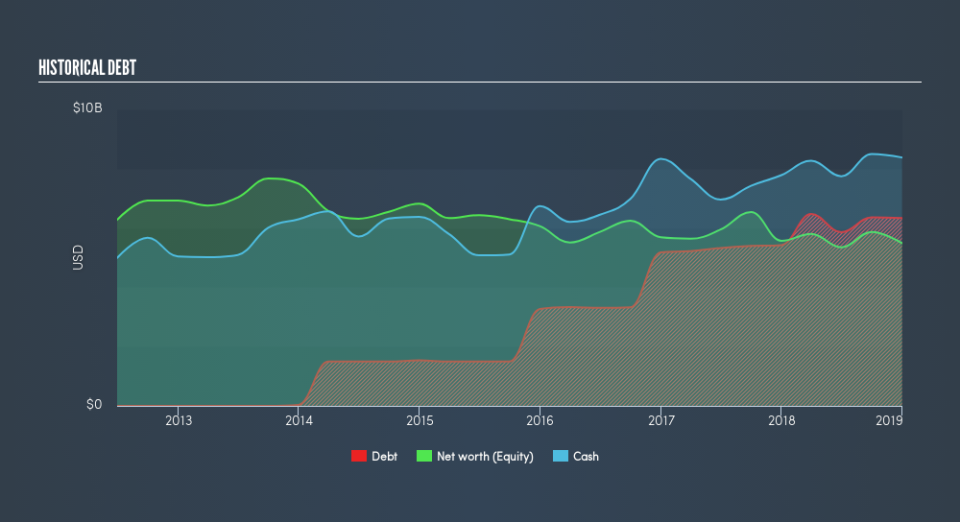Is Mastercard Incorporated's (NYSE:MA) Balance Sheet Strong Enough To Weather A Storm?

Want to participate in a short research study? Help shape the future of investing tools and you could win a $250 gift card!
Investors pursuing a solid, dependable stock investment can often be led to Mastercard Incorporated (NYSE:MA), a large-cap worth US$254b. Doing business globally, large caps tend to have diversified revenue streams and attractive capital returns, making them desirable investments for risk-averse portfolios. But, the health of the financials determines whether the company continues to succeed. Today we will look at Mastercard’s financial liquidity and debt levels, which are strong indicators for whether the company can weather economic downturns or fund strategic acquisitions for future growth. Note that this commentary is very high-level and solely focused on financial health, so I suggest you dig deeper yourself into MA here.
View our latest analysis for Mastercard
MA’s Debt (And Cash Flows)
MA has built up its total debt levels in the last twelve months, from US$5.4b to US$6.3b – this includes long-term debt. With this increase in debt, MA's cash and short-term investments stands at US$8.4b , ready to be used for running the business. On top of this, MA has produced cash from operations of US$6.2b in the last twelve months, resulting in an operating cash to total debt ratio of 98%, meaning that MA’s current level of operating cash is high enough to cover debt.
Does MA’s liquid assets cover its short-term commitments?
At the current liabilities level of US$12b, the company has been able to meet these commitments with a current assets level of US$16b, leading to a 1.39x current account ratio. The current ratio is the number you get when you divide current assets by current liabilities. Usually, for IT companies, this is a suitable ratio as there's enough of a cash buffer without holding too much capital in low return investments.
Is MA’s debt level acceptable?
Since equity is smaller than total debt levels, Mastercard is considered to have high leverage. This is common amongst large-cap companies because debt can often be a less expensive alternative to equity due to tax deductibility of interest payments. Consequently, larger-cap organisations tend to enjoy lower cost of capital as a result of easily attained financing, providing an advantage over smaller companies. No matter how high the company’s debt, if it can easily cover the interest payments, it’s considered to be efficient with its use of excess leverage. A company generating earnings before interest and tax (EBIT) at least three times its net interest payments is considered financially sound. For MA, the ratio of 132x suggests that interest is amply covered. Large-cap investments like MA are often believed to be a safe investment due to their ability to pump out ample earnings multiple times its interest payments.
Next Steps:
MA’s high cash coverage means that, although its debt levels are high, the company is able to utilise its borrowings efficiently in order to generate cash flow. Since there is also no concerns around MA's liquidity needs, this may be its optimal capital structure for the time being. Keep in mind I haven't considered other factors such as how MA has been performing in the past. You should continue to research Mastercard to get a better picture of the large-cap by looking at:
Future Outlook: What are well-informed industry analysts predicting for MA’s future growth? Take a look at our free research report of analyst consensus for MA’s outlook.
Valuation: What is MA worth today? Is the stock undervalued, even when its growth outlook is factored into its intrinsic value? The intrinsic value infographic in our free research report helps visualize whether MA is currently mispriced by the market.
Other High-Performing Stocks: Are there other stocks that provide better prospects with proven track records? Explore our free list of these great stocks here.
We aim to bring you long-term focused research analysis driven by fundamental data. Note that our analysis may not factor in the latest price-sensitive company announcements or qualitative material.
If you spot an error that warrants correction, please contact the editor at editorial-team@simplywallst.com. This article by Simply Wall St is general in nature. It does not constitute a recommendation to buy or sell any stock, and does not take account of your objectives, or your financial situation. Simply Wall St has no position in the stocks mentioned. Thank you for reading.

